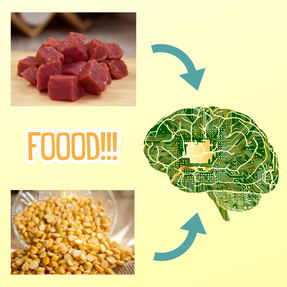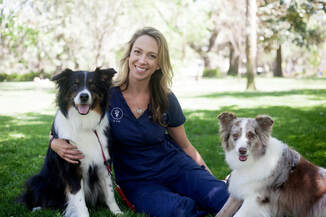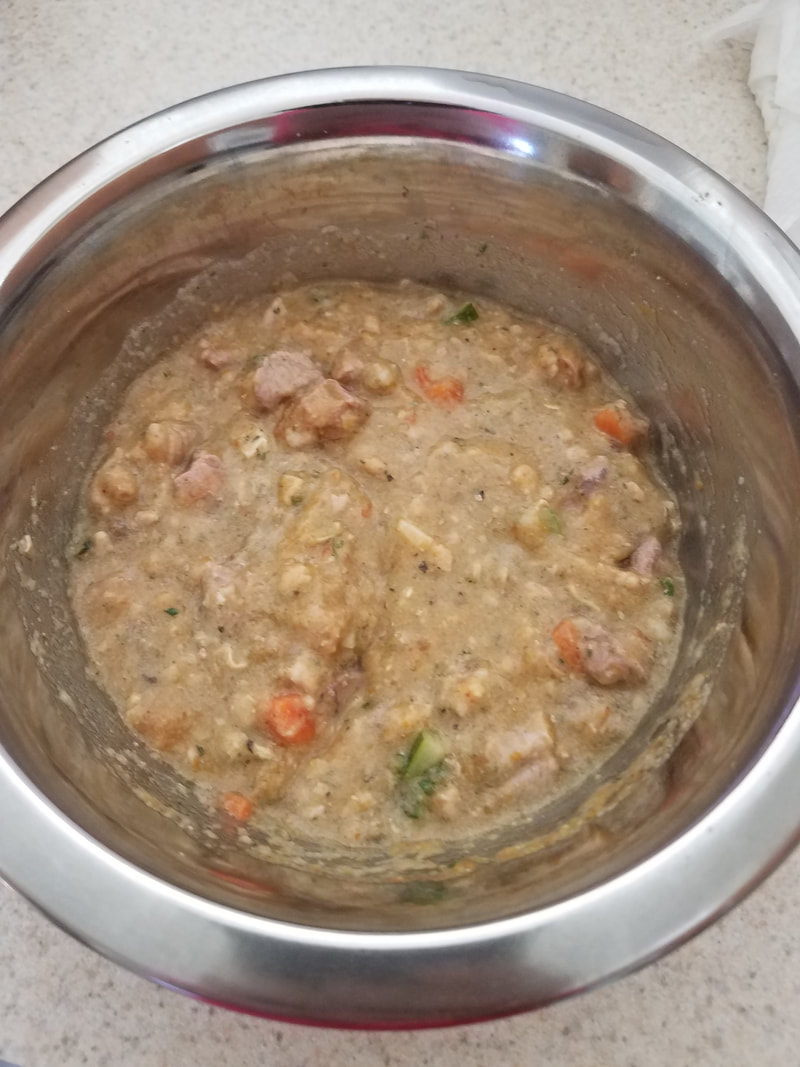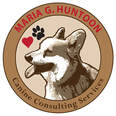What You Put IN Your Dog is What You Get OUT of Your Dog –
Some Canine Nutrition Suggestions
|
You’ve heard the phrase, “you are what you eat.” Part of being a canine behavior consultant is helping people understand the role that nutrition plays on keeping a dog healthy, and that means not only physically but emotionally and, therefore, behaviorally as well. There is a whole range of different foods on the market - some much higher in quality than others. I recommend educating yourself about these options and considering which fits best into your financial budget and comfort level - that way you can keep your dog healthier in mind and body, and with you for many years to come, without breaking your bank! |
How Nutrition Affects Behavior
Just like how we are not at our best and our bodies are not operating most efficiently when we are not getting the nutrition we need, the same is true for our dogs. If we are not eating enough roughage or taking quality probiotics to make up for the lack of good fiber in our diet, we get constipated and bogged down. If we eat too many donuts or processed foods, we gain weight, become sluggish and tend to have joint pain and inflammation. While there are certainly some differences in a dog’s body system functions compared to our own, some of their organs do function similarly to ours.
If a dog is ingesting ingredients that have been adulterated by a heavy refining process or with pesticides and hormones, etc – and what he is eating is no longer “real food” - he is more likely to develop health issues such as food allergies and arthritis, to name a few. A dog with allergies who is always having to deal with itchy skin or generally just not feeling well is more likely to be irritable. A dog with inflammation and arthritis may be more sensitive to being touched, physically restrained or approached by strangers because he’s in pain. A dog dealing with one or both of these stressors is more likely to be reactive, less tolerant of pressure and stress, protective of his personal space, and/or aggressive at the perceived “threat” of being touched (either by children or other dogs, etc).
Just like how we are not at our best and our bodies are not operating most efficiently when we are not getting the nutrition we need, the same is true for our dogs. If we are not eating enough roughage or taking quality probiotics to make up for the lack of good fiber in our diet, we get constipated and bogged down. If we eat too many donuts or processed foods, we gain weight, become sluggish and tend to have joint pain and inflammation. While there are certainly some differences in a dog’s body system functions compared to our own, some of their organs do function similarly to ours.
If a dog is ingesting ingredients that have been adulterated by a heavy refining process or with pesticides and hormones, etc – and what he is eating is no longer “real food” - he is more likely to develop health issues such as food allergies and arthritis, to name a few. A dog with allergies who is always having to deal with itchy skin or generally just not feeling well is more likely to be irritable. A dog with inflammation and arthritis may be more sensitive to being touched, physically restrained or approached by strangers because he’s in pain. A dog dealing with one or both of these stressors is more likely to be reactive, less tolerant of pressure and stress, protective of his personal space, and/or aggressive at the perceived “threat” of being touched (either by children or other dogs, etc).
|
Your dog requires a certain amount of proteins and carbohydrates to function adequately and this ratio is important. Protein provides the necessary tryptophan, an essential amino acid that is crucial in the production of serotonin, melatonin and vitamin B3 – which all work to regulate your dog’s emotional state and keep him calm and comfortable. The body does not produce tryptophan on its own so it must be provided from food. But again, the balance is key. Some recent studies are theorizing that too much protein can override tryptophan production, which may lead to fear or dominance aggression, as these behaviors can be diminished with tryptophan supplementation. Similarly, if a dog is eating more carbs (particularly wheat and corn) than animal-based proteins, the body will show an increase in blood sugar levels, which inhibits his brain function and leads to hyperactivity, and a decrease in tryptophan and serotonin (making it more difficult to help your dog calm down).
|
The body is a complex system and it’s easy to take it for granted. But when a body is running efficiently on all cylinders, your dog will be able to bring out his best. So what he gets from his food can have a profound effect on how he behaves.
The Kibble Conundrum
Dog kibble is easy to feed, convenient to purchase, and the least costly – all qualities we may gravitate towards when selecting an option for our pets. But did you know that kibble is actually the least healthy option we can bestow upon our furry friends?
Dog kibble is easy to feed, convenient to purchase, and the least costly – all qualities we may gravitate towards when selecting an option for our pets. But did you know that kibble is actually the least healthy option we can bestow upon our furry friends?
|
My friend Dr. Neely North, DVM of Savannah Holistic Veterinary Care is also a Certified Veterinary Food Specialist and helps her clients understand the process that kibble goes through before it ends up in your dog’s food bowl. “Kibble and canned foods are cooked at very high heat (>400F)/extrusion process and are then sprayed with rendered fat,” Dr. North says. They also contain acrylamide, a toxic compound that “will not be on the label because this occurs naturally with foods that go through the high heat extrusion process (>400F). A potato cooked above 250-300 degrees contains this (remember French fries!), but this is toxic to the esophagus and stomach as well as the nervous and reproductive system/genes.”
|
Since this information is not on the kibble bag label, it’s easy to think that it’s not a threat to our dogs. But just because something is not on the label or is approved by the Food and Drug Administration does not mean that it’s actually safe or healthy. Dr. North continues, “Acrylamide is also in coffee. It's correlated with cancer of oral cavity, esophagus, larynx, kidney, breast and ovary as per National Cancer Institute studies. Since it's naturally occurring in foods cooked with high heat, it's not considered to be a toxic ingredient by the FDA at this time.”
Many pet foods (most commonly kibble) are considered “feed grade”. Dr. North cautions her clients about this title. “Feed Grade means that only 15% of it has any manufacturing and quality control regulations; it is unfit for human consumption; can be deemed this due to the ingredients, packaging or handling of the food; it may include ingredients rejected /deemed unsafe or unsuitable for human consumption, such as sick/ euthanized animals. Feed grade foods also often contain mycotoxins (carcinogenic, hepatotoxic/nephrotoxic; they are also pro-inflammatory = IBD).” And, while repulsive to think about, “feed grade often contains rodents, roaches and bird excrement too.” Oh dear!!
Many pet foods (most commonly kibble) are considered “feed grade”. Dr. North cautions her clients about this title. “Feed Grade means that only 15% of it has any manufacturing and quality control regulations; it is unfit for human consumption; can be deemed this due to the ingredients, packaging or handling of the food; it may include ingredients rejected /deemed unsafe or unsuitable for human consumption, such as sick/ euthanized animals. Feed grade foods also often contain mycotoxins (carcinogenic, hepatotoxic/nephrotoxic; they are also pro-inflammatory = IBD).” And, while repulsive to think about, “feed grade often contains rodents, roaches and bird excrement too.” Oh dear!!
|
Lastly, cooking kibble at such a high heat also renders much of the nutritional content irrelevant. You may have to feed your dog twice as much food to get closer to the appropriate nutritional requirements (which means that while the bag available at the grocery store costs less than what’s available at the boutique pet store, you will likely be using more of it – so you may not be saving as much money as you think). While all kibble is processed, kibbles that are made in smaller batches and with better quality ingredients are the closest to “whole food” as a kibble can get. And even then, manufacturers have to add many synthetic vitamins and minerals to make up for what is lost during the cooking process. But as Dr. North will tell you, “Synthetic vitamins and minerals are not well absorbed, the body sees them as foreign. It's best to get these in whole food forms.”
|
Now I’m not saying that you can never feed kibble – even if it’s not my preference, I understand that for some, that is just the most logical option for their particular pet. But I caution you to pay attention to the labels and select the highest quality of kibble you can afford so you can make the most informed choice in providing your dog a healthier today and longer tomorrow!
How Do You Choose?
I recommend looking for a formula that has ingredients listed which you would eat yourself - such as meats (avoid by-products, as that also includes other parts of the animal like beaks, feet, etc), a "good" carbohydrate (healthy grains such as brown rice or quinoa are ok unless your dog has an allergy to grain, sweet potato or legumes like chickpeas, lentils, peas are usually better), and some vegetables and fruits.
The first couple of ingredients should be high-quality proteins, followed by a healthy carbohydrate source. Ingredients are listed on the label according to their percentages but keep in mind: a first ingredient of meat could make up 30% while the next ingredient, a carbohydrate, could make up 29%. So just because a bag says “meat as the #1 ingredient” doesn’t mean it’s a good quality food if that meat is then followed by several carbohydrates or filler ingredients like wheat, corn, soy or other glutens. I would strongly avoid these ingredients.
I recommend looking for a formula that has ingredients listed which you would eat yourself - such as meats (avoid by-products, as that also includes other parts of the animal like beaks, feet, etc), a "good" carbohydrate (healthy grains such as brown rice or quinoa are ok unless your dog has an allergy to grain, sweet potato or legumes like chickpeas, lentils, peas are usually better), and some vegetables and fruits.
The first couple of ingredients should be high-quality proteins, followed by a healthy carbohydrate source. Ingredients are listed on the label according to their percentages but keep in mind: a first ingredient of meat could make up 30% while the next ingredient, a carbohydrate, could make up 29%. So just because a bag says “meat as the #1 ingredient” doesn’t mean it’s a good quality food if that meat is then followed by several carbohydrates or filler ingredients like wheat, corn, soy or other glutens. I would strongly avoid these ingredients.
Often, I will use human restaurant analogies to help my clients understand the variation in the quality of kibbles available on the market today. Brands like Purina, Eukanuba, Pedigree, and Iams are, in my mind, nutritionally equivalent to fast-food chains like Burger King or Starbucks. These brands may be available virtually everywhere you go, but in order to be the same from franchise to franchise they are so mass-produced that the nutritional quality just isn’t there enough to be fed on a daily basis. They contain many artificial colors and preservatives, which a body views as “toxins” and doesn’t process efficiently (so they are often stowed as fat) and have even been linked to health issues like cancer. I recommend steering clear of these widely-available “fast-food” kibbles.
Then there are some brands that I consider “middle-of-the-road” in terms of their quality - they are like your chain restaurants such as Ruby Tuesday and Olive Garden. They’re not super - they are still mass-produced and are widely-available in more of your “big box” stores - but they are a bit better than the “fast-food” kibbles. Taste of the Wild, Wellness CORE, Hill’s Science Diet, Blue Buffalo, Royal Canin, Canidae are some of these brands.
Then there are some brands that I consider “middle-of-the-road” in terms of their quality - they are like your chain restaurants such as Ruby Tuesday and Olive Garden. They’re not super - they are still mass-produced and are widely-available in more of your “big box” stores - but they are a bit better than the “fast-food” kibbles. Taste of the Wild, Wellness CORE, Hill’s Science Diet, Blue Buffalo, Royal Canin, Canidae are some of these brands.
If you’re going to feed your dog kibble, some of the best-quality brands I typically recommend are Fromm, Zignature, Orijen and Acana. These are made in smaller batches with higher-quality ingredients. You won't be able to find any of those in a grocery or big box store, but can find them in the smaller boutique pet stores (in the Savannah area this includes stores like Bentley's Pet Stuff, Woof Gang Bakery, or Canine Palace to name just a few), or online through the manufacturer’s website, Amazon (because you can find everything on there!) or possibly Chewy.
A Healthier Option
Luckily with the expansion of boutique pet stores and online shopping, feeding your dog an alternative to kibble is easier than ever. And, you still have a few options that could work for you in spite of your busy schedule or budget.
Luckily with the expansion of boutique pet stores and online shopping, feeding your dog an alternative to kibble is easier than ever. And, you still have a few options that could work for you in spite of your busy schedule or budget.
|
Dehydrated food:
This form of diet is not processed and molded like kibble, but rather a combination of whole foods that have been selected for their nutritional content and either dehydrated or freeze-dried (maintaining the most nutrition) and then ground into a powder or formed into a crumbly nugget. You then have to add water to hydrate it before feeding and it ends up having the consistency of a wet food. While it may look just like goo to us, many dogs find it palatable because of the limited, whole-food ingredients. The Honest Kitchen, Grandma Lucy's, Stella & Chewy's, and Primal are four brands that carry high-quality dehydrated foods. I have been feeding The Honest Kitchen to my own dog for quite some time and he loves it! Dr. North also recommends The Honest Kitchen to her clients. “The Honest Kitchen uses steam treated meals - no high heat cooking, comes freeze dried, and contains human grade ingredients from a human grade facility. Their entire supply chain and production process have been reviewed by the FDA and the food they produce is fit for human consumption.” While that doesn’t mean we should eat it ourselves, it means we could – and we could rest assured knowing that our pets are receiving the quality food they need and deserve. Additionally, Dr. North recommends Nom Nom Now, Evermore pet food and, if you have your holistic veterinarian help you pick foods, a home cooked diet is one of her favorites. |
Home-Cooked Meals
I understand that sometimes you may not have time to cook food for yourself let alone for your dog, but if you plan ahead it doesn’t have to take up that much time. A home-cooked meal that has been cooked at a lower temperature (think "low and slow," like in a crock pot) and with fresh ingredients retains the most nutrition and can keep your dog functioning at optimal capacity. This kind of diet can also be much more effective in helping your dog overcome (or proactively avoid) many common health risks.
In addition to his Honest Kitchen, my dog’s diet consists of half home-cooked meals. I buy him meat and vegetables when I buy my own meat and vegetables at the grocery store, and I spend about 1.5 hours to make about 2 weeks worth of food. After selecting the ingredients for that particular batch of food (I usually vary it per 2-week batch to give him a variety for both taste and nutritional content), I chop the meat and vegetables just small enough to go in my crock pot and I let them simmer for 6-8 hours on low heat. After they cool, I drain out the liquid (which I can then use later to rehydrate his Honest Kitchen food) , and put the chunks in my food processor to make them smaller/more of a puree consistency (which is easier for absorption). The size crock pot I use allows me to make enough food to fill one airtight container to keep in the fridge for this week's food, and also another container to store in the freezer for next week's food.
I then add some of his home-cooked diet to his Honest Kitchen, along with his supplements (which usually include a multivitamin/superfood/prebiotic blend I use called NutraThrive, as well as an organic nutritional supplement for musculoskeletal support given his age and breed) and he's ready to eat! I also usually give him a daily dose of some raw goat's milk or kefir for probiotics, and/or you could also add a little bit of canned pumpkin for fiber if you choose.
I understand that sometimes you may not have time to cook food for yourself let alone for your dog, but if you plan ahead it doesn’t have to take up that much time. A home-cooked meal that has been cooked at a lower temperature (think "low and slow," like in a crock pot) and with fresh ingredients retains the most nutrition and can keep your dog functioning at optimal capacity. This kind of diet can also be much more effective in helping your dog overcome (or proactively avoid) many common health risks.
In addition to his Honest Kitchen, my dog’s diet consists of half home-cooked meals. I buy him meat and vegetables when I buy my own meat and vegetables at the grocery store, and I spend about 1.5 hours to make about 2 weeks worth of food. After selecting the ingredients for that particular batch of food (I usually vary it per 2-week batch to give him a variety for both taste and nutritional content), I chop the meat and vegetables just small enough to go in my crock pot and I let them simmer for 6-8 hours on low heat. After they cool, I drain out the liquid (which I can then use later to rehydrate his Honest Kitchen food) , and put the chunks in my food processor to make them smaller/more of a puree consistency (which is easier for absorption). The size crock pot I use allows me to make enough food to fill one airtight container to keep in the fridge for this week's food, and also another container to store in the freezer for next week's food.
I then add some of his home-cooked diet to his Honest Kitchen, along with his supplements (which usually include a multivitamin/superfood/prebiotic blend I use called NutraThrive, as well as an organic nutritional supplement for musculoskeletal support given his age and breed) and he's ready to eat! I also usually give him a daily dose of some raw goat's milk or kefir for probiotics, and/or you could also add a little bit of canned pumpkin for fiber if you choose.
If you’re not sure how to go about planning a home-cooked meal for your dog (as you will certainly want to do your research to ensure you are providing what your particular dog needs), please consult with your holistic veterinarian as Dr. North recommends. If you don’t have one, please reach out to Dr. North herself! She would be happy to assess your dog’s needs and help you build a diet that will suit him.
The proper nutrition is vital for any living being, and in today’s fast-paced society where we rely on immediate gratification and convenience it can be easy to let that slip to the wayside. But a little education can go a long way - and your dog will thank you by bringing out his best self and by sharing more years of his life with you!
Written by Maria Huntoon, Maria G. Huntoon Canine Consulting Services















